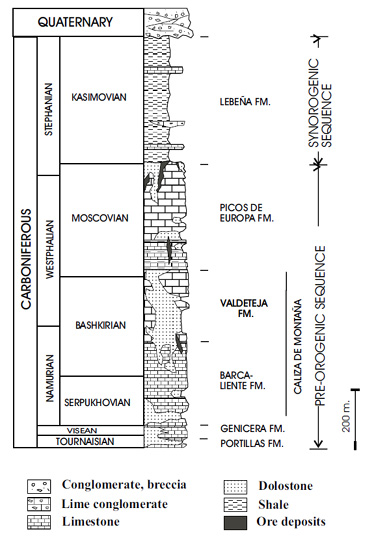Geology
Aliva deposit is hosted by intensely dolomitized limestones of Carboniferous age; the genetic type of mineralization corresponds to the Mississippi Valley-type ore deposits. Complete geologic and metallogenetic study of Zn-Pb deposits in the Picos de Europa region was carried out by F. Gómez-Fernandez et al. and published in European Geology Magazine (2000).
According to these authors, the formation of Zn-Pb is attributed to epigenetic hydrothermal mineralization during Permian age (250-300 million years ago) due to sulphides precipitation from hot brines charged with metals migrated toward and through carbonate rocks by means of convective circulation. The fluid source would probably marine waters of Carboniferous age contained in detrital sediments of underlying Palentine zone and limestones of the Picos de Europa zone, although other sources may contributed.
Geological cross section through the southeastern region of Picos de Europa (click to enlarge)
(Gómez-Fernández et al., 2000).
Stratigraphy of the southeastern sector of Picos de Europa (Gómez-Fernández et al., 2000).
(click to enlarge)
On a base of fluid inclusion study combined with tectonic reconstruction, the cited authors estimate the minimum depth of formation of Aliva deposit as 1.050 m and the minimum temperature between 170º y 200ºC. From the fluid inclusions study was concluded that chloride complexes were responsible for metal transportation.
The marine waters would have been the source of chloride, and their heating during tectonic processes would have resulted in alteration of host rocks, releasing the metals such as Zn and Pb into the aqueous phase. The metals precipitated as ore minerals are believed to be originated from numerous black shale units of underlying Palentine zone. Mineralized zones are locally controlled by faults and dolostone-limestone contacts. Precipitation of sulphide ores produced as a result of pH increase due to reaction with carbonate rocks, with other contributing factors as temperature, pressure and salinity decrease of the mineralizing fluids.
The mineral textures indicate rapid deposition of the type I mineralization (laminated sphalerites with very small inclusions of other sulphides) and slower deposition of the type II mineralization with development of large crystals.






